Porosity - CT Scanning Services
Part Inspection Lab
We help companies internally inspect
suspect parts for porosity using our
CT scanning services
POROSITY
Most of our clients identify porosity inspection with physical destruction or cutting of the product to identify porus areas within a casting, composite, or plastic injection molded part.
Our advanced (Computed Tomography) CT Scanning services which uses x-ray technology is able to aid manufacturers in providing a quantifiable NDT inspection process for idnetifying porosity in 3D within suspect parts.
Our porosity analysis lab produces high quality and accurate 2D / 3D X-Ray datasets of internal part features and material density changes. Data captured includes porosity and inclusions, allowing clients to benefit from our non-biased results.
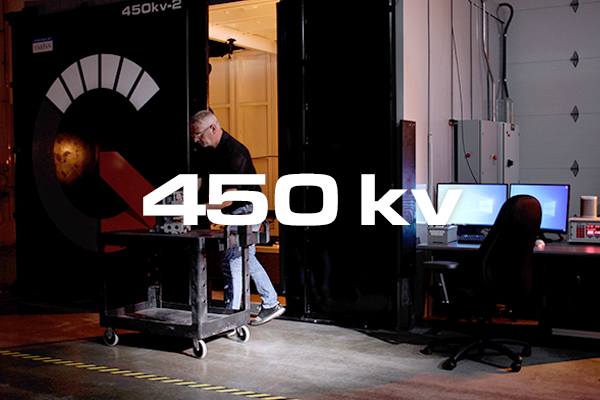

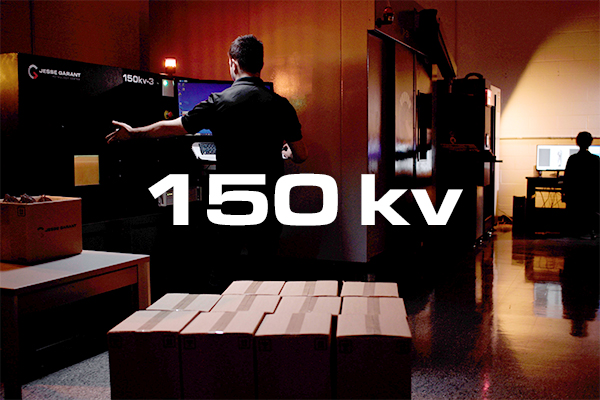
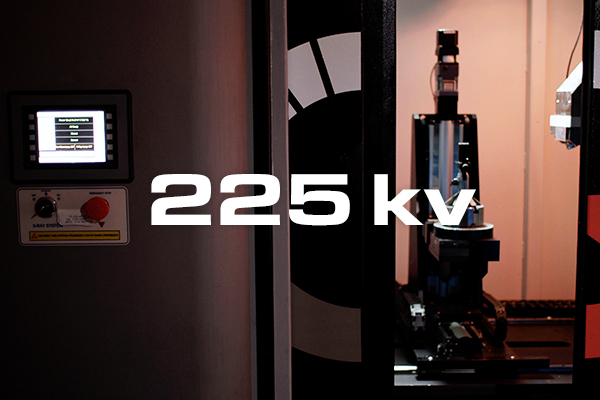
POROSITY
CT SCANNING SERVICES
In addition to volume, each pore can be identified within a part by its coordinate X, Y, Z location and individual sizes. Percentage of porosity within the entire part or within a specific area can also be supplied. Results are then sorted in a chart similar to an excel database which the end user can query to the desired parameters.
Inclusion Analysis – Just like creating a boundary around lower densities within the part for a void analysis, boundaries can be identified around higher density materials within a part to locate inclusions.
BENEFITS
- Results can clearly identify internal porosity and cracks where 2D x-rays show inconclusive or no results.
- Results can be quantified by volume and location for each internal void or pore
- Parts no longer have to be cut up to locate internal porosity
Need more info on porosity?
Review our knowledge section below.
Porosity (Overview)
Overview
Accumulation of porosity can become damaging to the functionality and quality of a part. Quickly and accurately identifying, locating, quantifying and documenting porosity defects is necessary to ensure all parts are within specified porosity tolerance.
Introduction
Accumulation of porosity can become detrimental to the quality and functionality of any component. Traditionally, users would cut open parts to identify and measure internal porosity to determine the most feasible method of reducing or removing all porosity. Technologically advanced testing methods, such as industrial Computed Tomography (CT) allow users to identify, locate, measure and access the orientation of internal porosity in 3D, without destroying the part.
This has provided users with an outlet to gain accurate insight for defects within parts quickly, enabling users with information to identify ways of ensuring porosity is within tolerance.
What is Porosity?
Porosity within a part or component, is a measure of pore volume or void space. The measurement is a ratio of the volume of pores or voids, in comparison to the total volume, which can be identified as a percentage. Porosity is identified as a defect, which can adversely affect the quality and/or functionality of a part or component. Porosity is a term often miscommunicated as an inclusion. Even though both terms are classified as a defect, an inclusion is used to describe impurities or irregularities within a part that consists of foreign material, which can be the result of human error or poor handling for example. However, porosity is essentially a cavity or an empty space or hole within a part. Porosity can commonly be found across multiple industries within materials including metals, composites, polymers, ceramics, silicone and glass, to name a few.
How Porosity is Commonly Formed
Porosity can be formed in several different types of materials and can be accumulated through various manufacturing methods. Some methods of manufacturing, such as porous media molding commonly used for polymers, attempt to develop parts with desired controlled porosity for different applications. Other manufacturing methods have tight tolerances and industry standards for the level of porosity accepted. Moreover, many materials are preferred by manufacturers, as they have better characteristics to avoid accumulation of porosity.For example, a cast part with aluminum A206 is prone to develop hot tears, creating defects, as oppose to a cast part made with aluminum A356. There are many different ways porosity can be developed on the surface of a part or internally, including the design intent of the part. The method of manufacturing can also play a significant role in accumulating porosity, in regards to the machine pressures for machined components, heating and cooling temperatures for cast parts, mold design for molded components or the sintering process for sintered metals, to name a few.
Die Casting: Pores
There are various different forms of die casting porosity. The most commonly identified form of porosity in die casts include gas porosity and shrinkage porosity. Gas porosity commonly appears to have rounded edges caused by trapped mold in the metal, whereas shrinkage porosity appears to have jagged edges due to inadequate solidification of the casting.
Porosity in die casts can be developed subject to many different factors including, but not limited to, the type of material being used, machine speed and compression, mold design, cast geometry and design, or metal and mold temperatures. The focus of the caster is to identify the type of defect, the frequency of occurrence for that defect, the location of the defect and to quantify the size of the defect, subject to specific standards of porosity tolerance. Understanding and documenting porosity characteristics assists casting supplier and manufacturer in identifying adjustments or changes that can be made in design and machining to avoid defective output. Often times however, porosity formation in die cast applications can be mended, using welding applications.
Common Methods of Detection
The two most common methods of detecting porosity within a part include X-ray testing and destructive testing. With the application of digital radiography (x-ray testing), users are able to seek out internal location and frequency of occurrence of porosity. This allows users to confirm that the porosity formation is within tolerance, without damaging the part in its entirety. Destructive testing methods enable users to cut open the part to visually inspect internal porosity. This will automatically scrap the part and can often provide inaccurate or misleading assumptions about the defects.
For an extensive and accurate approach for conducting a failure analysis on parts to identify porosity, users also have access to industrial Computed Tomography (CT). Industrial CT can provide users with internal and external part data on porosity occurrence, location, orientation and measurements. The most effective feature for Industrial CT is the fact that it is completely nondestructive and provides results in 3D, giving users access to the depth of porosity. This can play an instrumental role in qualifying parts and re-adjusting design to ensure porosity is within tolerance.
Purpose of Detection
Whether it is a composite material, aluminum or steel casting, or a plastic injection molded component, formation of large porosities can become detrimental to the quality and functionality of any part. If these defects are not identified and quantified, the overall cost of the part, allocation of scrap parts and cost of quality control process can increase exponentially. Identifying and quantifying porosity can assist users in understanding the need to adjust design or even change manufacturing process, to avoid accumulation of porosity in the future. However, having porosity within a part does not disqualify the part immediately. Manufacturers and industry leaders must develop standards according to their own specifications and applications to understand the minimum and maximum porosity tolerances, in order to qualify a part for specific applications. Users must define maximum level of porosity acceptable in certain areas, subject to how critical the areas are to the functionality of the component.
Industry Standards: Porosity
The Minerals Managements Service (MMS) provides standards of porosity for components such as valves and fittings. The American Society for Testing and Materials (ASTM) has identified standards for porosity in castings. These standards have a relatively general approach, which many companies rely on for manufacturing parts. These are also commonly referenced and used as a foundation in order to develop project specific tolerances for various applications.
Porosity & Inclusion
Our Porosity/Inclusion Analysis provides a range of algorithms allowing porosity/inclusions to be located within the object and provides detailed information about these defects. Porosity or inclusions are color-coded in all 2D and 3D views of the data set. Detailed information about each individual defect such as its volume, projected size and position are provided in a table.
By using the metrology data, this information can also be specified with the highest possible precision in any calibrated coordinate system. Statistical data about the overall object such as its porosity (in percent) or the sum of all defect surfaces complete this information.
A porosity/inclusion analysis can be performed on an entire scanned object. Using the ROI concept, it is also possible to restrict such an analysis to relevant areas or to perform porosity/inclusion analyses using different parametes in different areas of an object.
The results of a porosity/inclusion analysis can be compiled to create an inspection report, optionally including automatically generated or individually selected images.
Features
- automatic and fast detection, analysis and visualization of pores or inclusions in the material
- volume, position, size and surface area are determined for every individual pore/inclusion
- color-coding of pores or inclusions according to volume
- defect size statistics, total percentage of porosity and pore volume histogram
- analysis of the entire object or Regions of Interest
- user-defined reporting of analysis results
Porosity/Inclusion Analysis Features
Locate pores, holes, and inclusions within parts and get detailed information on these discontinuities:
- Detect, characterize, and visualize porosity in 2D and 3D using computed tomography.
- Distinguish between gas pores, shrinkage cavities, cracks, and inclusions of foreign material.
- Take wall thickness analyses and subsequent machining steps into account.
- Automatically quantify the surface size of discontinuities in 2D CT slice images in accordance to BDG Reference Sheet P 201/P 202. (Extended Porosity/Inclusion Analysis Module)
- Perform a 3D evaluation with regard to the most critical porosity parameters within functional areas of the part in accordance to BDG Reference Sheet P 203. (Extended Porosity/Inclusion Analysis Module)
- Get results for later use in subsequent simulations.
- Use data in statistical evaluation software such as Q-DAS qs-STAT.
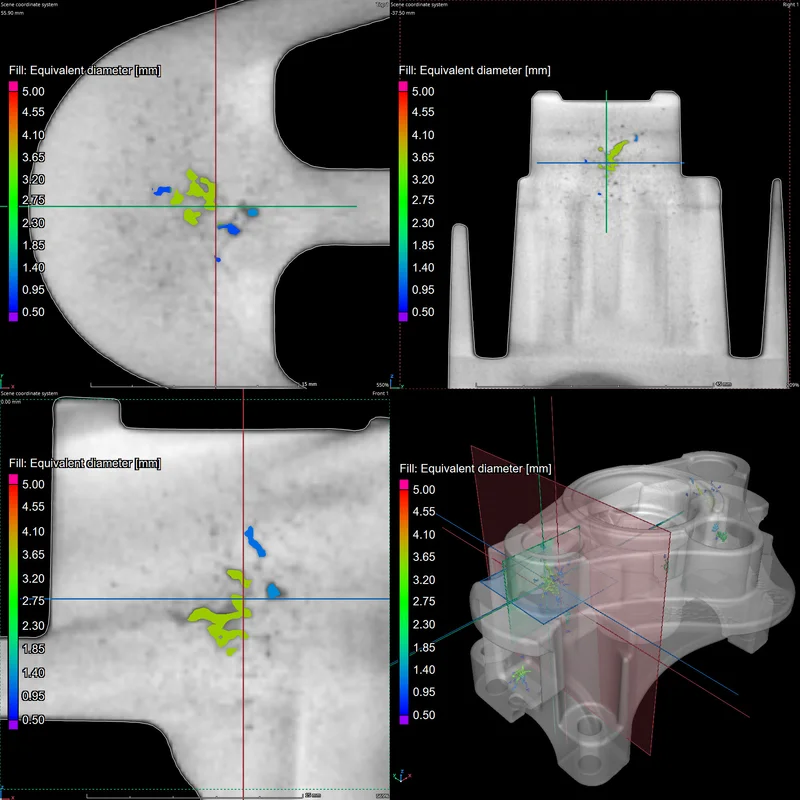
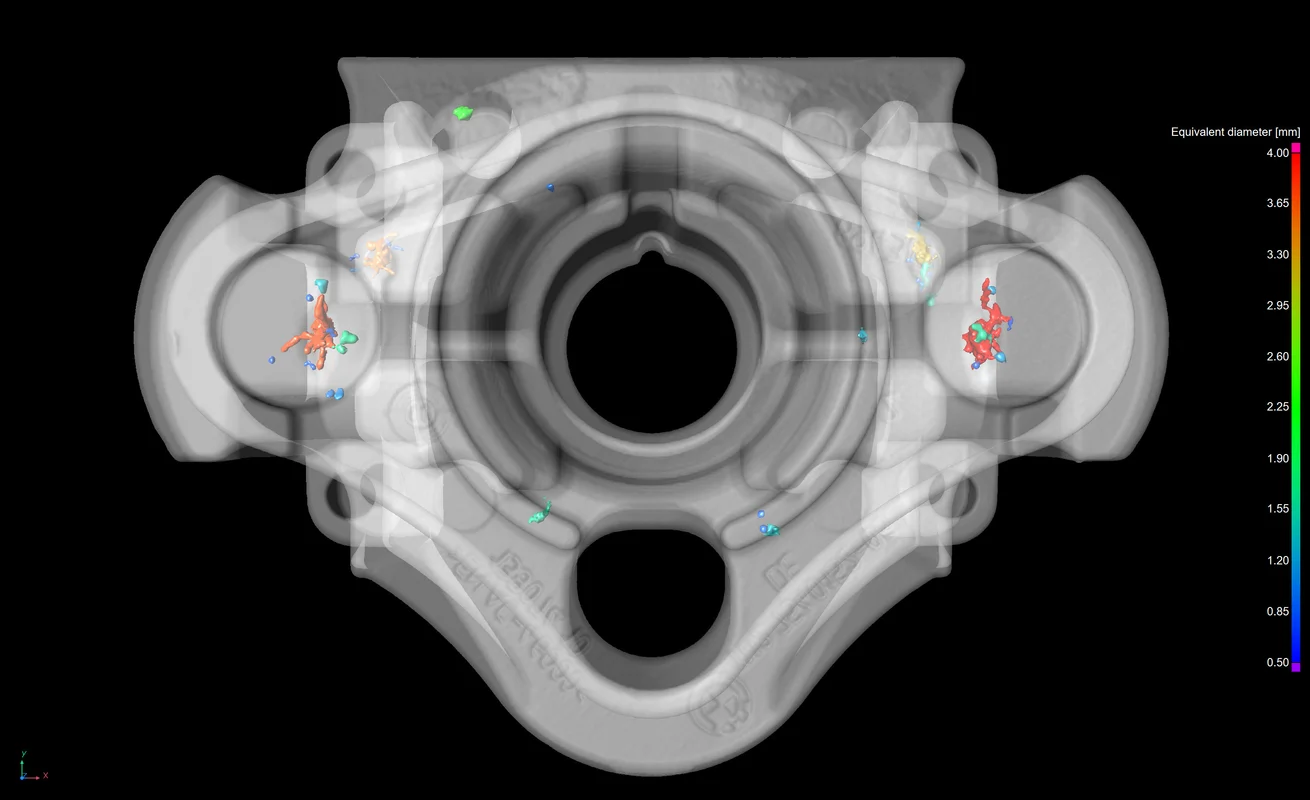
Determine these global porosity parameters for the entire component:
- Total pore volume
- Total material volume
- Total porosity
- Total surface of the pores
- Projected total area of all pores in any spatial direction
Determine these parameters for individual pores:
- General:
- Position
- Deviation of gray values
- Minimum, maximum, and average gray value
- Size:
- Volume
- Surface
- Equivalent diameter (diameter of a sphere with the same volume)
- Radius or diameter of the circumsphere
- Shape:
- Compactness
- Sphericity
- Shape of fitted ellipsoid (from a Principal Components Analysis)
- Projected dimensions:
- Projected length in arbitrary spatial directions
- Projected area in arbitrary spatial directions
- Additional features:
- Classification (inside, outside, or cut from the machined surface)
- Minimum and maximum edge distance
- Cut surface with component surface
- Distance to next pore (gap)
- Wall thickness at the location of the pore
- Relative diameter (i.e., diameter of the pore relative to the local wall thickness)
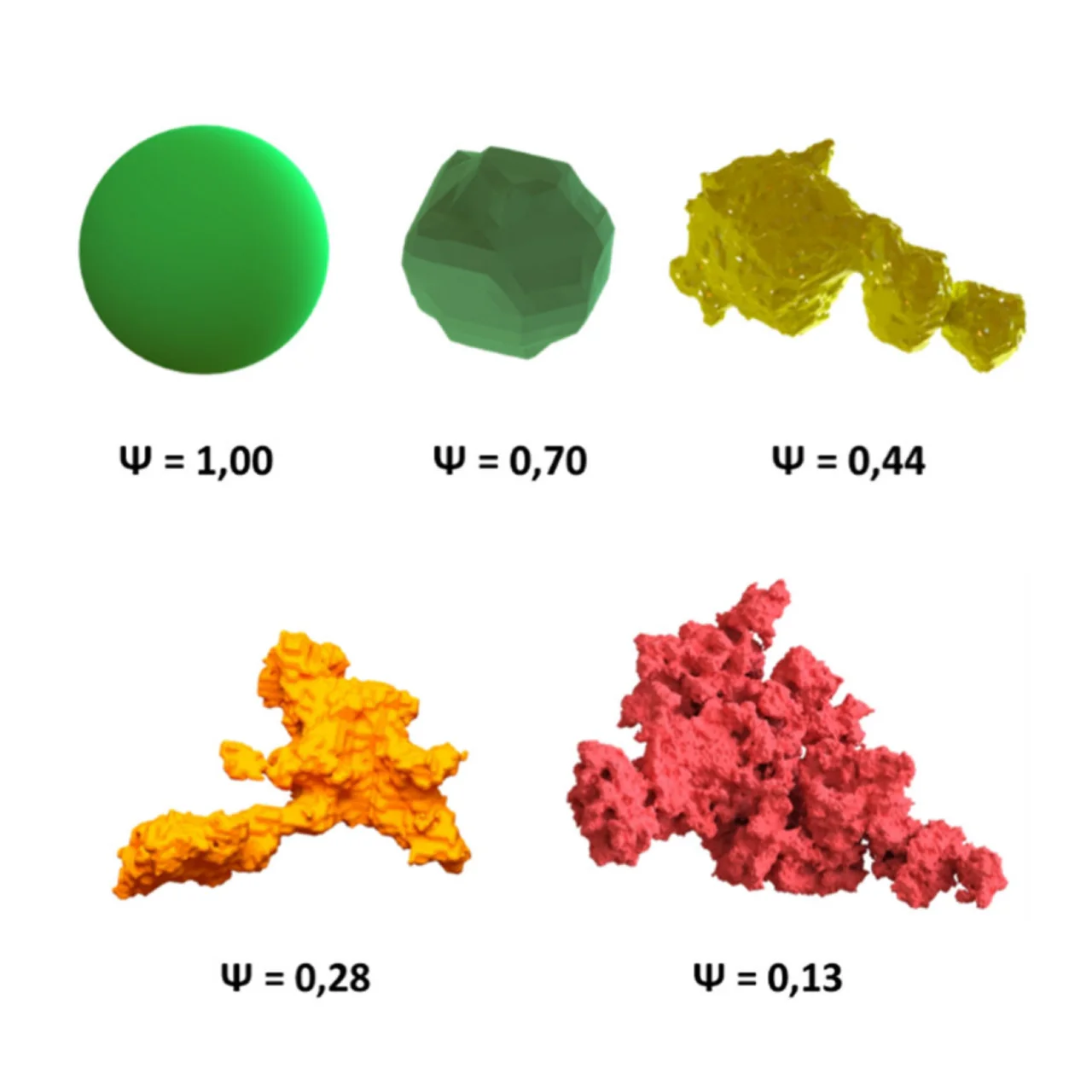
Sphericity (Source: BDG – P 203 / www.bdguss.de)
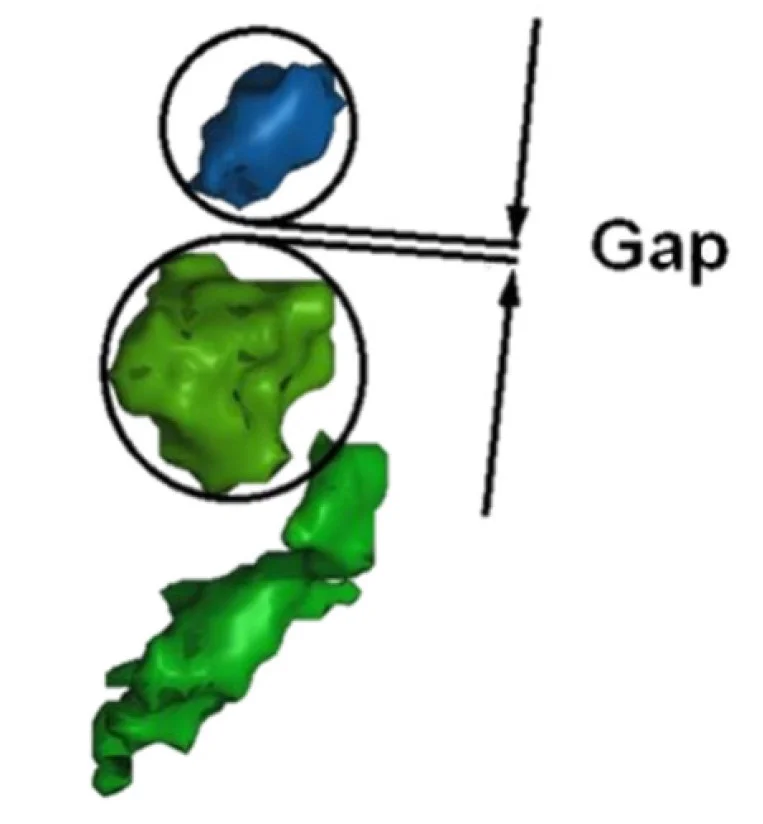
Distance to next pore (Source: BDG – P 203 / www.bdguss.de)
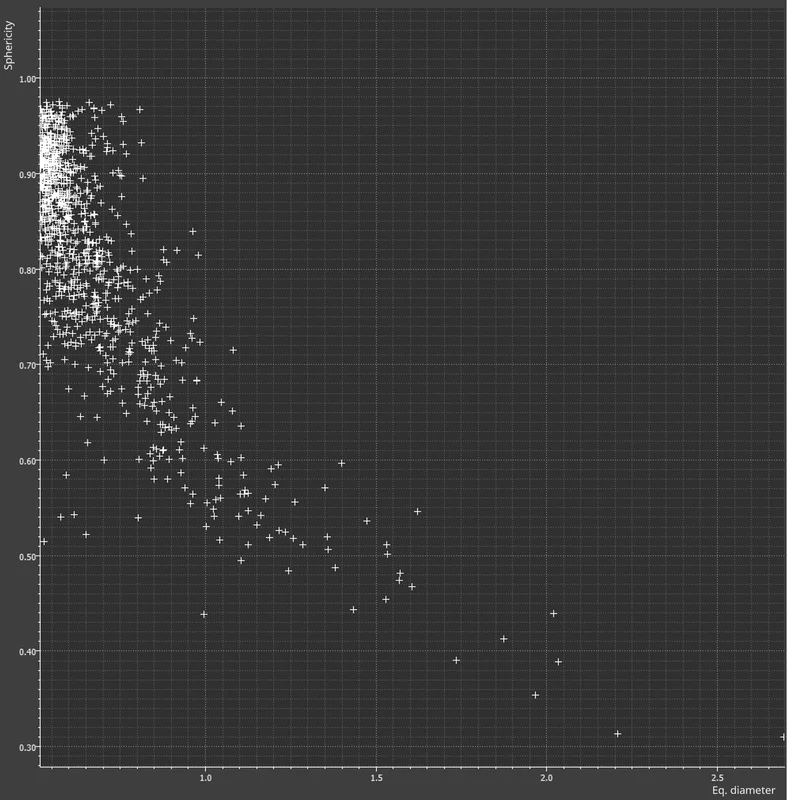
Dependencies between Porosity Parameters
In addition to the calculation and tolerancing of porosity parameters, you can easily display dependencies between porosity variables using suitable graphical representation in y-x plots. For example, a plot of the sphericity against the equivalent diameter may show that the larger pores are shrinkage holes, which can be identified by their lower sphericity.
Histograms
The distribution of the values of a corresponding parameter can be displayed using histograms. The following example shows that the majority of discontinuities are characterized by a small relative diameter. Those with a relative diameter close to one will be considered critical, since the spatial extent and the minimum wall thickness in the area of the pore are in the same order of magnitude.
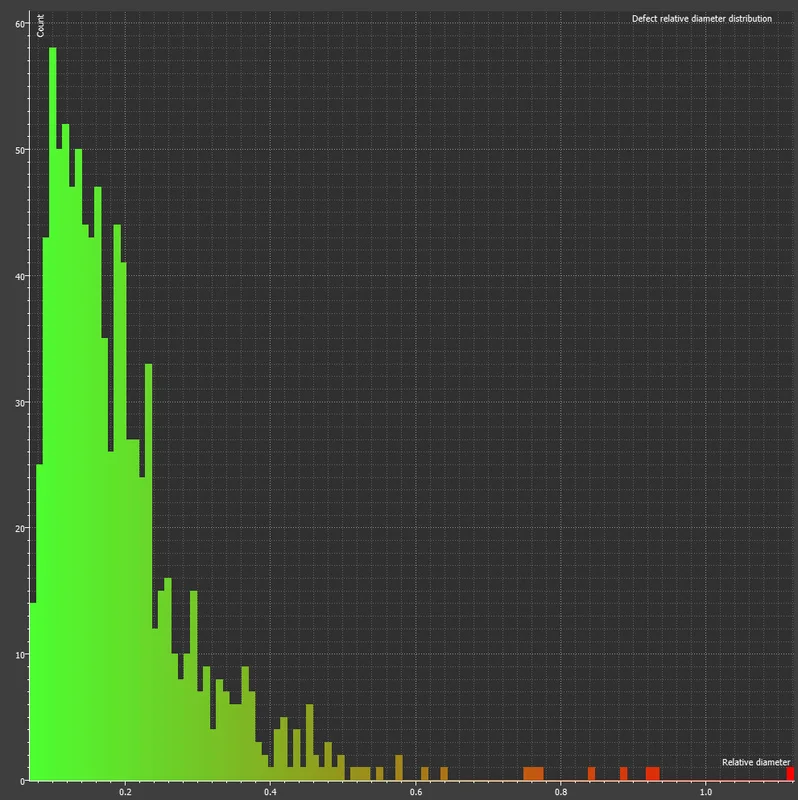
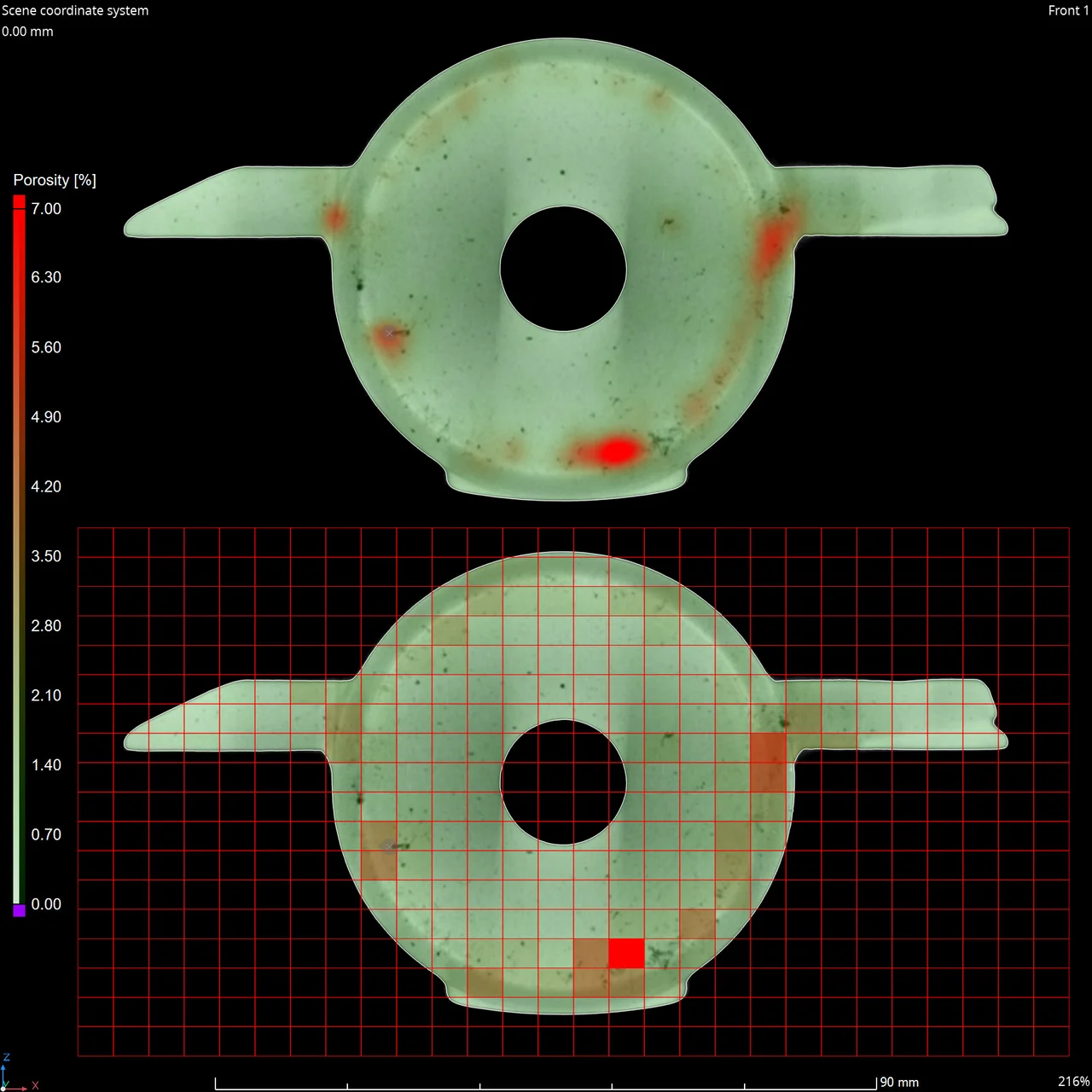
Local porosity (top) and local porosity in a volume mesh (bottom)
Local Porosity Calculation
Since not only single discontinuities are crucial for component stability, Volume Graphics software also offers the opportunity to investigate porosity accumulations and their effects in more detail.
Besides calculating local porosity and local concentrations, it is also possible to map porosity in cells of volume meshes. Regular meshes can be used as well as volume meshes adapted to the CAD or the real surface.
Practically Relevant Results
The results for certain porosity parameters allow you to draw conclusions such as:
- Total porosity: Fluctuations in the production process can be detected easily by monitoring the total porosity over a longer period of time. An increase in this value may indicate unsuitable casting speeds or insufficient venting of the mold cavity.
- Sphericity: The sphericity value, which is calculated from the pore volume and the pore surface area, allows you to distinguish between gas pores (which are characterized by higher sphericity values) and shrinkage holes (which have lower sphericity values). Knowledge about the shape of discontinuities supports process optimization and also provides information about the durability of the component.
- Distance to surface: By calculating the distance to any surface, you can check sealing and thread surfaces for suitability before machining. The porosity analysis simulates the surface to be processed. The depth of the remaining porosity in the machined area can be calculated and visualized. This is, for example, important for sealing surfaces, since air inclusions in open pores can displace the sealing material under thermal stress.

Sphericity
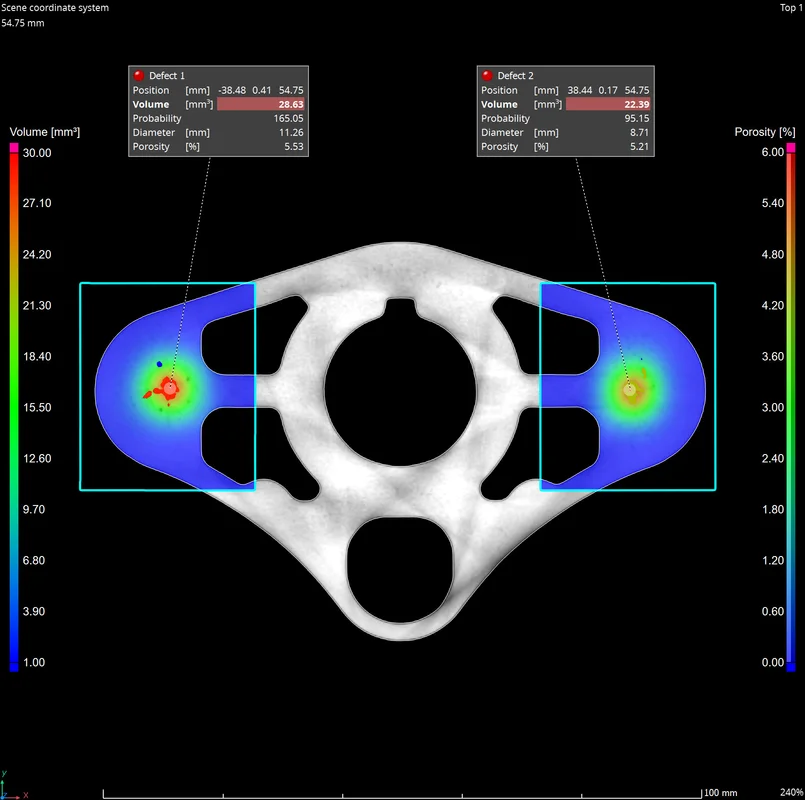
Focus on Functional Areas
Limit analyses to relevant areas:
- With regions of interest (ROIs), you can apply porosity analyses to specific regions of the part using different filter and tolerance settings. For example, the porosity analysis can be limited to the area of the casting skin if the goal is to examine gas pores near the casting skin surface.
- Discontinuities can be linked with wall thicknesses.
Shows whether and how pores would be cut during machining:
- Pore position and size can be calculated not only in relation to the current component surface but also to any other surface.
- Thus, you can include subsequent machining of the part (for example, drilling) in a porosity analysis and determine the distances of the pores to a machined surface. In particular, you can check whether pores would be cut, rendering the machined surface useless. This way, you can sort out a part before cost-intensive machining.
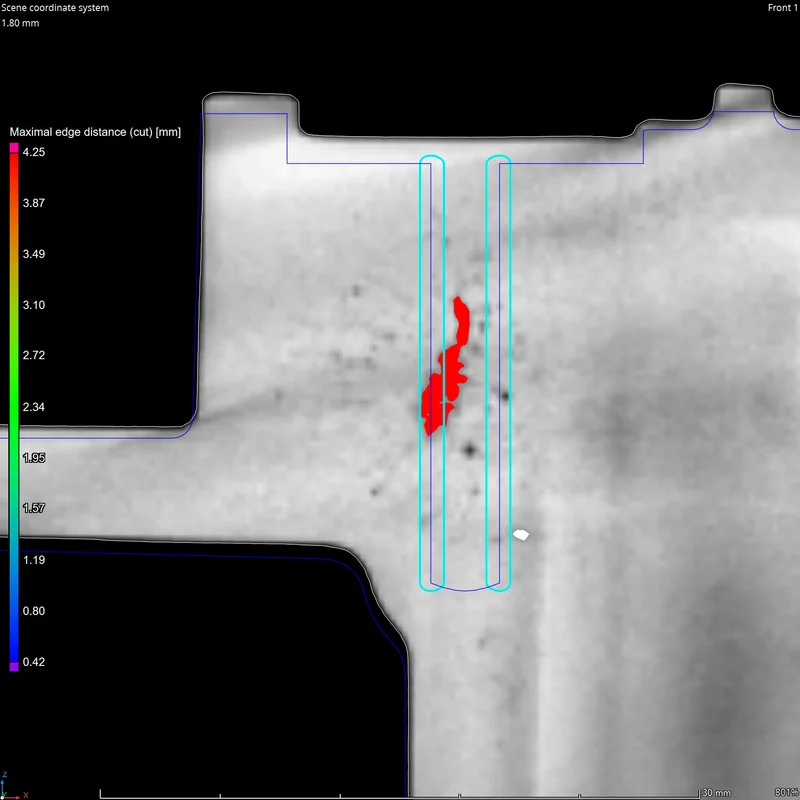
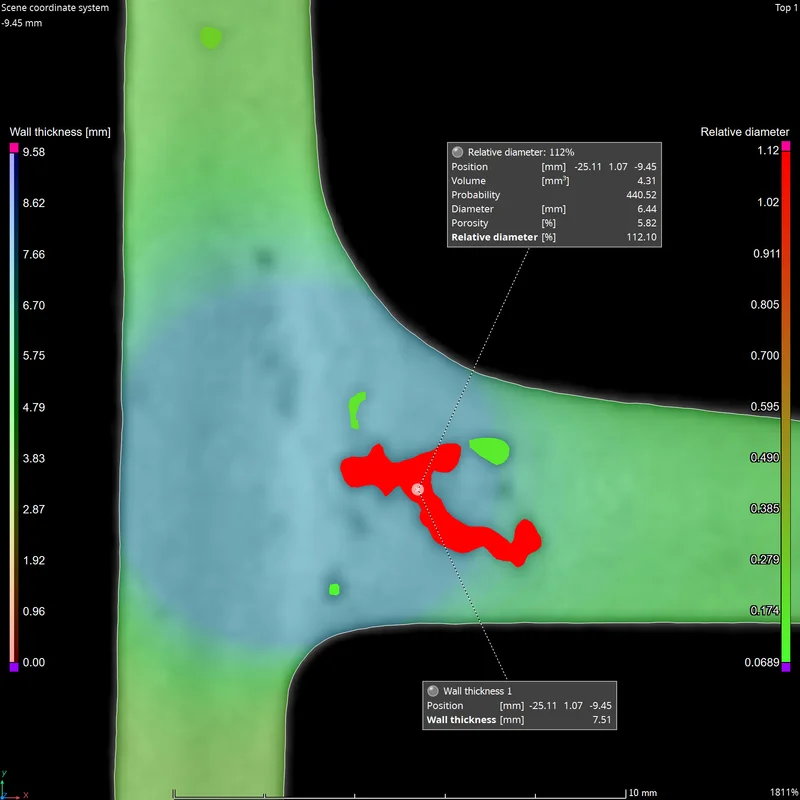
Perform tolerancing with decision trees:
- Automate casting inspection by defining the tolerances for individual porosity parameters for functionally relevant areas (special attributes)—e.g., number, size, and position of individual pores—while defining the tolerances for the entire casting as global porosity parameters (for example, maximum total porosity in %).
- Map more complex issues by combining tolerance statuses of individual analyses, which is especially useful in automated inline scenarios. For example, a casting can be classified as “not okay” if a certain porosity has been exceeded and there is a huge amount of porosity in the region of the cast skin. If none of the parameters are exceeded, the part is marked as “okay.”
Workflows and Interfaces
Easy Visualization
Unlock the real value of your results with the comprehensive yet easy-to-use visualization features.
Navigation in individual parts and series of parts:
- Discontinuities can be colored according to a selected parameter
- Discontinuities are displayed in a combination of 2D and 3D views
- Analysis markers can be created manually and automatically
- A series of parts can be reviewed in VGinLINE APPROVER
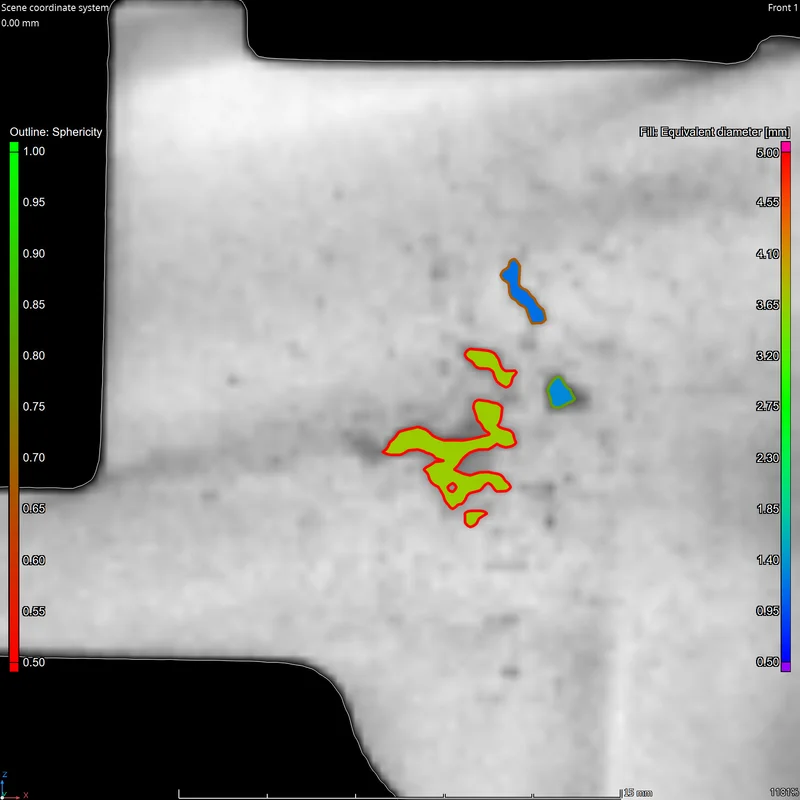
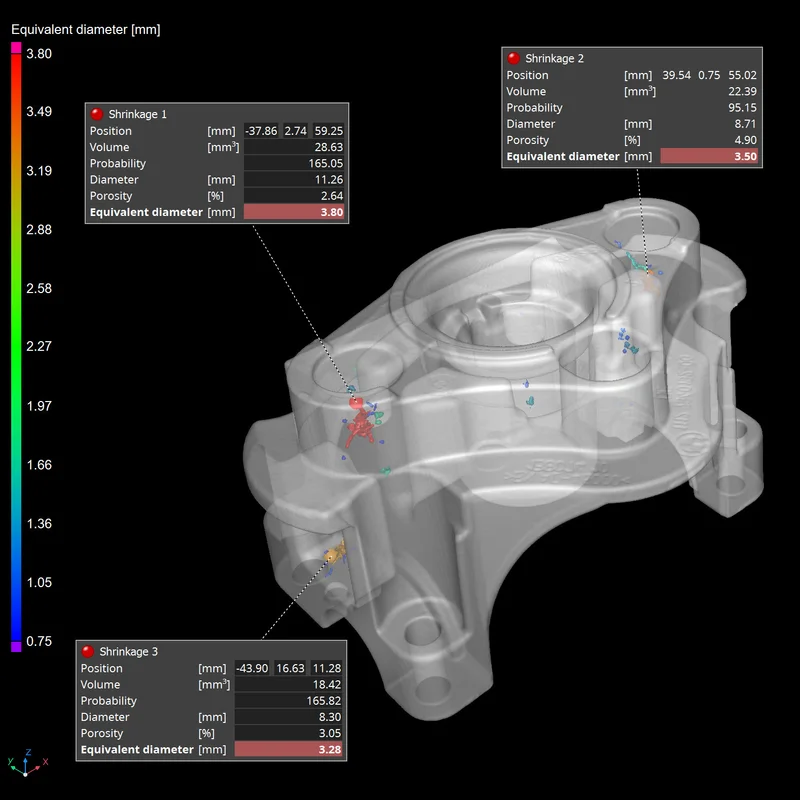
Manual and automatic image generation:
- Volume Graphics software offers various options to generate images of regions and discontinuities.
- If desired, these images can also show all porosity parameters directly in the image by means of analysis markers in addition to the position in the part.
- Standard views, such as orthographic views of the casting with detected pores, can provide a clear overview of a part.
- Rule-based image generation allows you to automatically get images in certain scenarios, such as when tolerance values are exceeded.
Inclusion Analysis
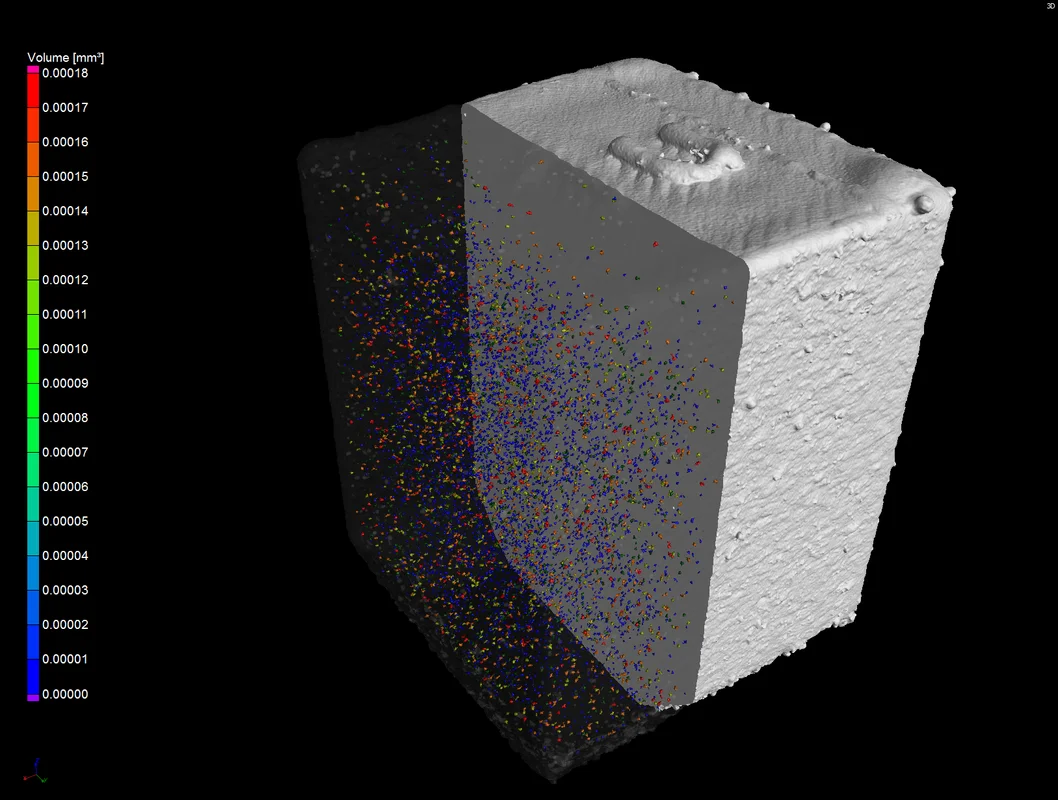
Detect particles within your part. The analysis of discontinuities can refer to the absence of material—the classic pore/voids analysis—as well as the presence of foreign particles.
With Volume Graphics software, you can detect unwanted contamination, such as in cases of machine wear, or explore the intended accumulation of added functional particles, such as metal flakes inside an insulator. All parameters that have been mentioned for porosity can also be determined for inclusions.
Enhanced Porosity P201, P201, P203 (Automotive Industry Specific)
This analysis was developed by Volkswagen to ensure each part does not exceed the maximum porosity percentage in key structural areas of a part. Upfront in the development stage parts are assigned a maximum pore percentage value within the part.

The OEM then provides call outs to these pore locations on supplied part prints. Next to each call out, a value is provided which lists the maximum allowable pore size percentage. These “D” values along with the area of the cross sectional slice noted on the part print are required to run this analysis. If the part print is not clear, please contact your OEM point of contact. Once a part has been CT scanned, a void analysis is performed to identify all areas of porosity within the part. The dataset is then cross sectioned according to the specified cross sections on the part print. After executing the analysis, the results are quantified and marked as either “go” or “no go” which lets the customer know if the part has met the part print requirements for each location.
*Note – In addition to the P-201 analysis identifying porosity percentage within a specific area, the program also analyzes in each area for: the size of the largest void, the number of voids, the proximity of one void to another, and the proximity of one void to the outside boundary of the part.
Conforming to Standards
The Extended Porosity/Inclusion Analysis Module supports three of the most important guidelines for porosity analysis in order to make evaluations for cast parts easily understandable and reproducible: BDG Reference Sheets P 201, P 202, and P 203.
To classify porosity parameters in slice images, VDG Specification P 201 (VW 50097) as well as BDG Reference Sheet P 202 (VW 50093) is used. These analyses provide a digital, fully non-destructive take on the classic micrograph analysis, which was achieved by sawing open the component.
With the analyses according to VDG – P 201 and BDG – P 202, you can tolerance the following parameters in arbitrarily oriented digital component sections by means of a porosity key:
- Maximum surface porosity
- Maximum pore diamenter (equal area of circle [ØF])
- Maximum length of pores (“Ferret”; compared diameter [ØL])
- Minimum normalized distance between adjacent pores
- Maximum number of pores
The evaluation is performed both in the entire section and in reference areas (square, rectangle, triangle, circle) set by the user.
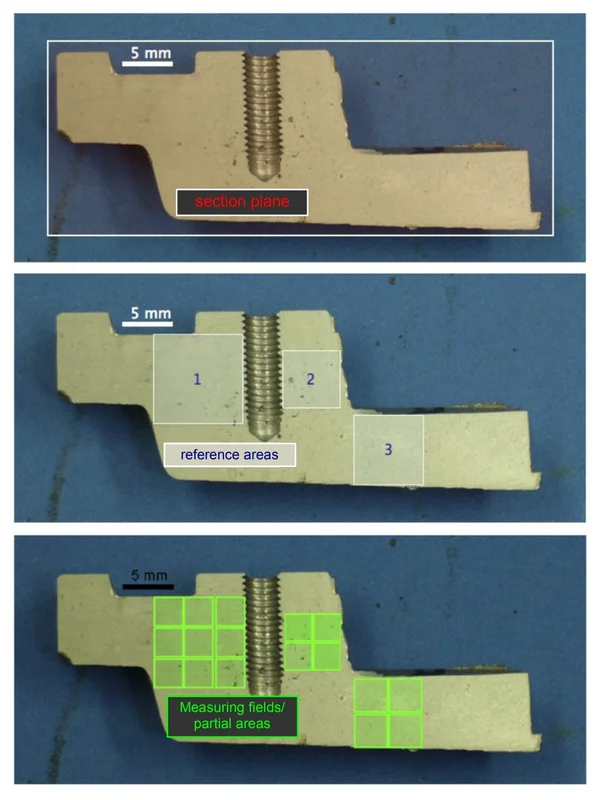
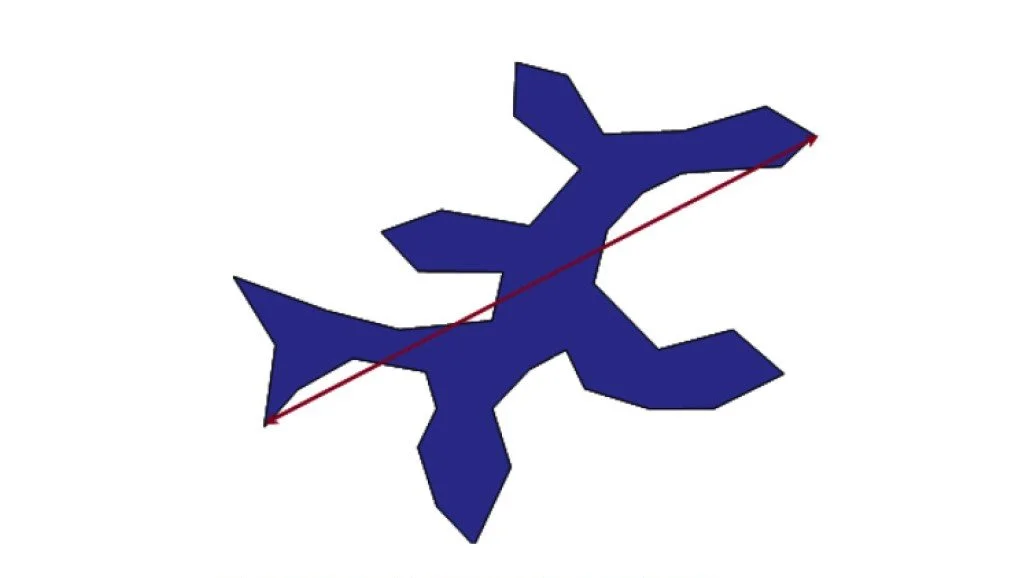
Pore length (= maximum Ferret) or analogy diameter [ØL] (Source: BDG – P 202 / www.bdguss.de)
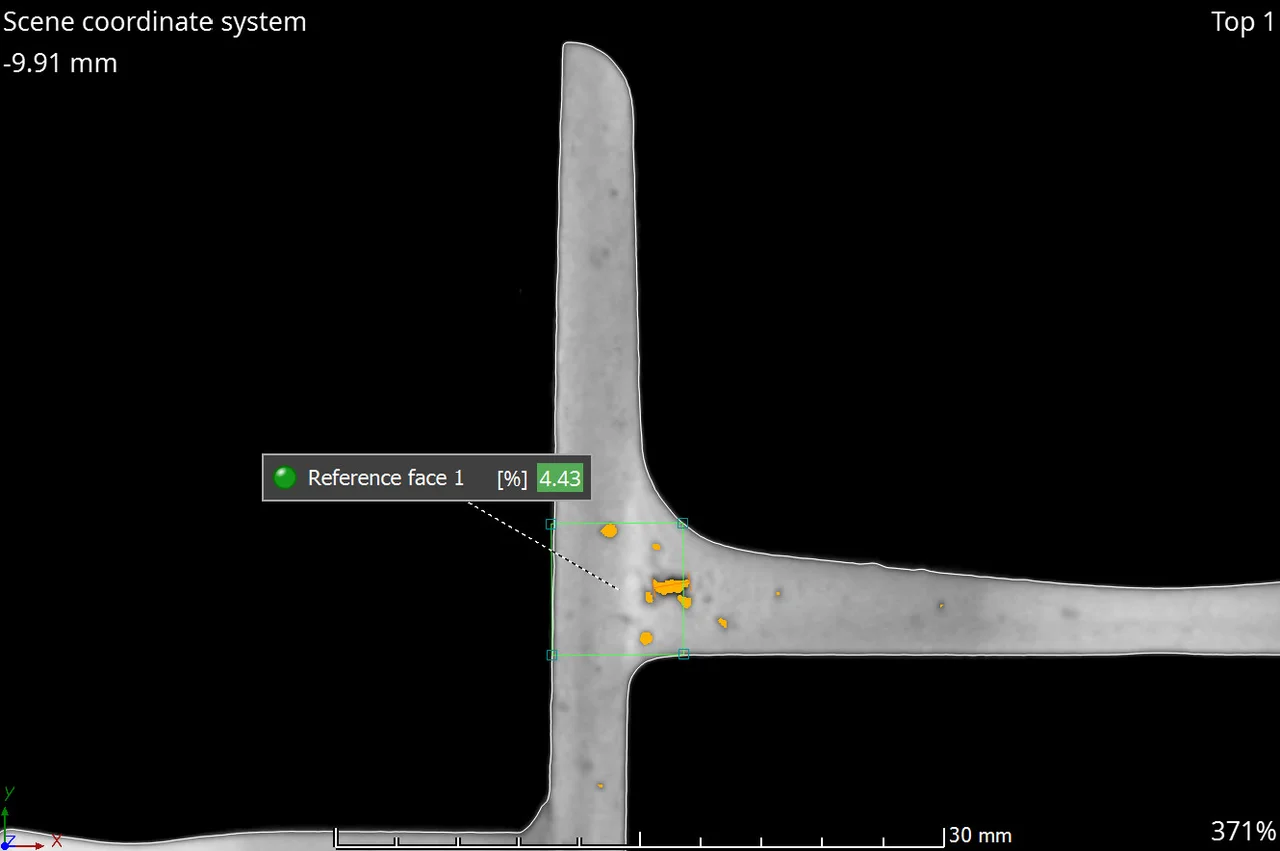
P 202 Analysis
The BDG Reference Sheet P 203 not only extends VDG – P 201 and BDG – P 202 to 3D but also puts an additional focus on the specific assessment of functionally relevant part areas by using free-form regions.
Volume Graphics software integrates important specifications according to the BDG Reference Sheet P 203 for the definition of the volume for pore assessment as well as for the definition of three-dimensional characteristics of internal volume deficits. Intuitive input functions make it easy to define porosity specifications based on the porosity key according to BDG – P 203.
Volume Graphics software supports the fully automatic determination of the called “Q factor” as proposed by the BDG Reference Sheet P 203. The Q factor is a simple, user-independent approach for verifying the quality of the gray value volume and documenting the quality of your CT scan data directly in the P 203 analysis.
Volume Graphics software also allows you to perform the porosity analysis according to BDG – P 203 on raw parts with additionally inserted reference surfaces, such as a 3D CAD machined part. This allows you to evaluate the porosity on the to-be-machined surfaces in advance.
You can automatically display the corresponding BDG P 203 porosity key and the analysis results for each analyzed freeform partial volume (ROI) in the 3D window and the 2D windows. This simplifies the evaluation of the porosity analysis as well as the orientation in the examined data set. Quick OK/NOK (“not okay”) decisions can be made and documented.
You will also receive the number of NOK (“not okay”) pores for selected porosity parameters that are out of tolerance within the global volume and within a freeform partial volume (ROI). This allows you to differentiate between outliers and a systematic production problem, which leads to better process control.
Furthermore, the porosity key according to BDG – P 203 can also be used to exclude discontinuities from the evaluation due to their porosity parameters, such as gas pores and micro-cavities with a maximum diameter of, for example, 0.6 mm.




